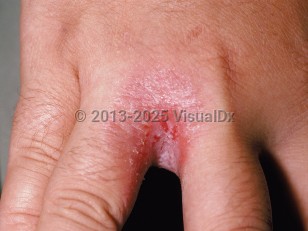Mucous membrane infections:
- Thrush, or oral candidiasis, is normally seen in infants younger than 1 year or older than 12 years but can be seen in children on medications such as antibiotics or chemotherapy, in immunodeficient children, or in asthmatic patients who take inhaled steroids. The infection manifests as white plaques on the lips, tongue, and palate that bleed on superficial scraping.
- Vulvovaginitis occurs commonly in pubertal and postpubertal girls and can arise due to antibiotic or corticosteroid therapy or in adolescent girls who are taking oral contraceptives. Patients complain of pruritus and discharge along with dysuria and dyspareunia in sexually active girls.
Diaper dermatitis: Candidal diaper dermatitis develops when sufficient moisture in the diaper area allows C albicans to proliferate and invade the stratum corneum. Children may experience burning on micturition.
Intertrigo: This form of candidiasis is more prevalent in obese or diabetic children. Intertrigo commonly occurs in the axillary region, intergluteal cleft, inguinal folds, and other body folds. Patients frequently feel itchy in these areas. Predisposing factors include moisture, heat and maceration, obesity, and tightly fitting clothing. The skin presents with red erythematous macules with surrounding satellite lesions.
Erosio interdigitalis blastomycetica: In erosio interdigitalis blastomycetica, children may develop candidal infection of the web spaces of their fingers or toes if they are constantly moist or remain immersed in water for a long period of time.
Candidal folliculitis: Folliculitis is infection of the hair follicles. Although usually localized, it may become widespread and must be differentiated from folliculitis caused by dermatophytes and tinea versicolor.
Male genital candidal infection: Genital candidal infection in boys can manifest as either balanitis or as erythema of the scrotal area or penile shaft.
Chronic mucocutaneous candidiasis: Chronic mucocutaneous candidiasis is a genetic syndrome linked to defective cell-mediated immunity to Candida antigens in which children experience recurring candidal infections. Chronic skin lesions appear as hyperkeratotic crusted lesions and nail dystrophy. The affected nails are thickened, brittle, and yellow-brown in color and have associated paronychia. Most cases develop in childhood and adolescence.
Nail: For nail involvement, see paronychia and onychomycosis.
Related topic: disseminated candidiasis (systemic candidiasis)



 Patient Information for
Patient Information for 
